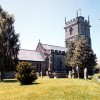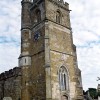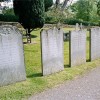Early in the 19th century, following a century of decline and neglect a program of church building and restoration was embarked upon on a scale not seen before or since. Nationally, between the turn of the century and 1850 two thousand new churches were built and building continued at this pace until 1870. Dorset played its part in this revival with Ferry and Crickmay taking the major part of the projects here, but this was to change in 1850 when a new man arrived in Dorchester and quickly established himself as an ecclesiastical architect.
John Hicks was born in Totnes in Devon; he was the son of John and Frances Hicks. His father was a clergyman and schoolmaster. John Champion Hicks uprooted his family from Devon and moved to Rangeworthy in South Gloucestershire, where he was appointed vicar. His son, John, who had received a good education and was a classical scholar, started an architectural practice in Bristol in 1837. Not much is known of his time there or where he trained, but we do know he designed and built two churches and had restored another by 1848.
It was John’s older brother, James, who first moved to Dorset. In 1837 he was curate at Piddletrenthide and became vicar there in 1845, a post he held for forty years. It was probably James who encouraged John to move to Dorset after his marriage at Rangeworthy in 1850 to Amelia Coley. We know from the 1851 census that John and Amelia were living at the Manor House at Piddletrenthide. ‘John Hicks: Architect’ is listed in a directory for 1852/3, which shows him at 39 South Street, Dorchester. He and his wife lived above the office, next door to William Barnes’ school.
Commissions came into the office for vicarages in Dorchester and Lyme Regis, a school and school house at Long Bredy and church restoration work at Piddletrenthide. But it was his work in 1859 at Rampisham that really established him in Dorset as an ecclesiastical architect; here he added a nave and side aisle. After Rampisham there was a steady flow of commissions and he built or restored nearly thirty Dorset churches before his death in 1869.
On 11th of July 1856 John Hicks took on the son of a local builder. He was articled to Hicks for three years and because of his youth this was extended for a further year. In the summer of 1860 the young man entered John Hicks’ employment as a paid assistant but left in 1862 before going to London to gain more experience and to pursue a career in writing. He returned to Dorchester and was again Hicks’ assistant from 1867 until his death in 1869: he was, of course, Thomas Hardy.
For those of us outside of the world of architecture and from this distance in time John Hicks is, without doubt, Dorset’s best known Victorian architect. However, our memory of him may have less to do with his work and more to do with his association with Hardy.
By all accounts John Hicks was a “genial, well-educated, straight dealing man” who was much liked. His work was generally admired and appreciated. Unusually for such a prominent man we have not been able to find an obituary to him in the Dorset County Chronicle, other than a simple death notice: ‘February 12th at Dorchester, in his 54th year, Mr John Hicks, Architect’.
Thomas Hardy dedicated his poem ‘The Abbey Mason’ to him and Florence Hardy noted in 1927 that Thomas Hardy had commented that “if he had his life over again he would prefer to be a small architect in a county town, like Mr Hicks at Dorchester.”



